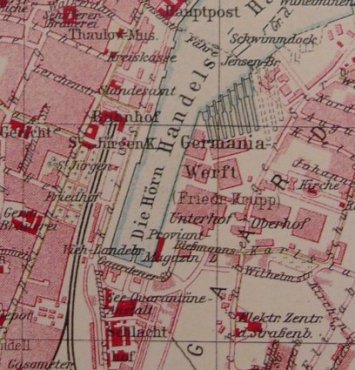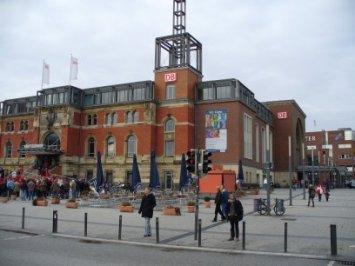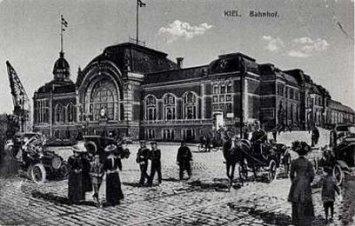Homepage Renate and Klaus Kuhl - Sailors' revolt in Kiel
Virtual Sightseeing Tour "Kiel Mutiny" Nov. 1918
[01] [02] [03] [04] [05] [06] [07] [08] [09] [10] [11] [12]
No. 11: Kiel central station
The station was playing an important role during the clashes: troops supposed to quell the uprising, arrived here and had to turn back and showed solidarity, some fights during the next days took place also near the station, and many soldiers already left Kiel being aware that the war was over, but also in an effort to spread the revolution further, and thus to stabilize the situation in Kiel. Since a few days no trains went, many sailors walked to Neumünster and took a train from there.
| Present day map | Former map |
|
Größere Kartenansicht |
 |
| Extract from a 1910 map (town archive). | |
| Present day view | Former view |
 |
 |
| The station on 8 Nov. 2009 (final rally of a commemoration ceremony) as seen from the water side; photo K. Kuhl | Photo postcard Kiel railway station in 1910 as seen from the land side; from http://kiel.ingowelt.de |
Further information:
The diarist of the Germania shipyard (engineer Nicolaus Andersen, see www.kurkuhl.de -> November revolution -> contemporary witnesses) describes some of the events at the station:
Monday, 4 Nov. 1918: Workers walk around with soldiers’ guns.
Everybody to the station. Navy blocks the station. However, some
trains still arrive. Marine officers are disarmed and led by strong
sentries to the Hansa-Hotel and the "Europäischer Hof" under abusive
shouts of the crowd. At 3 pm about 200 men infantry from Neumünster
with mashine guns arrived at the station, they manned the entrances
at around 6". I get the Volks-Zeitung (newspaper) at the counter
with the help of a petty officer. At 9 "the sailors were the masters
of the station. They only allowed in travelers in plain clothes
in civil, but many sailors. The soldiers from Neumünster had in
any case withdrawn. Later suddenly, after loud cheers, soldiers
of the Infantery Regiment. No. 84 come out of the station individually
without weapons and make common cause with the sailors. They hand
over their guns, ammunition and machine guns to the Navy. Great
fraternisation and cheers for the infantry. Field-gray helmets
were thrown away, caps put on and fuss made. Sailors went about
with field-gray helmets and deck officer's swords.
Later, at about 11" to the station. Huge crowd at the north portal
and enthusiasm. Hundreds of infantrymen between thousands of workers,
sailors, civilians and - girls and boys, the infantrymen slowly
disappeared in the station and have been transported off without
arms. A car took a machine gun including shooters and ammunition.
Wild confused ordering and hullabayoo. All of the sailors by and
by are armed.
At 1" back home, because it was cold. Hardly the bed stands a
murderer ROYAL shooting. I get out. At the station deserted. Just
in bed a gruelling shooting starts. I out. At the station deserted.
People shoot (allegedly out of the Hansa-Hotel and namely by officers)
at the soldiers. The hotel is considerably shot, as well as several
houses in the street Sophienblatt, like clockmaker Blunck and
corner Lerchensteet opposite also. When it quiet, I go through
the tunnel along the southern side of the station. A lorry comes
Ringstr. and gets under strong fire from all sides. Unfortunately
sailors are the occupants. When the shooting has stopped, they
find a Petty Officer Second Class with a shot in the leg and a
sailor with a shot in the chest. An ambulance picks them up. Sad
sight.
I had to kneel behind a gas lantern candelabra. The bullets were
flying. A petty officer next to me shoots standing freehand one
bullet after another into the hotel and after the automobile.
Then, long meetings and group formation. Setting up of a machine
gun near the accident annunciator and portal-building of farmers.
Wait corner Voss for Hussars from Wandsbek, but at about ½ hour
(?) they still had not come. With ice-cold legs home. The bitterness
against shooting officers is huge.
The virtual sightseeing tour at a glance:
- Holtenau viaduct and locks >>
- Large drillground (Großer Exerzierplatz) >>
- Karlstraße / Langer Segen >>
- Torpedo workshop Friedrichsort, Germania shipyard Kiel-Gaarden >>
- Barracks (Kasernen) in Kiel-Wik >>
- Marinestation Ostsee >>
- Arrestanstalt (military prison >>
- Trade union house (Gewerkschaftshaus) >>
- Town hall (Rathaus) >>
- "Schloßhof" >>
- Station (Bahnhof) >>
- Graves of the killed revolutionaries and soldiers >>
Real, guided tours on this subject are offered by:
- Geo-Step-by-Step >>
- Ernst Mühlenbrink, via Society for Kiel's Town History
(Gesellschaft für Kieler Stadtgeschichte) >>
- AKENS, Asche Arbeitskreis >>
Last modified: 13 Nov. 2011
| Sailors' Revolt / Kiel Mutiny November 1918 - here you'll find the following further information:
|
